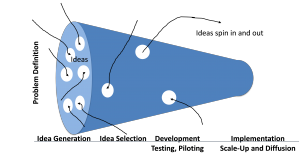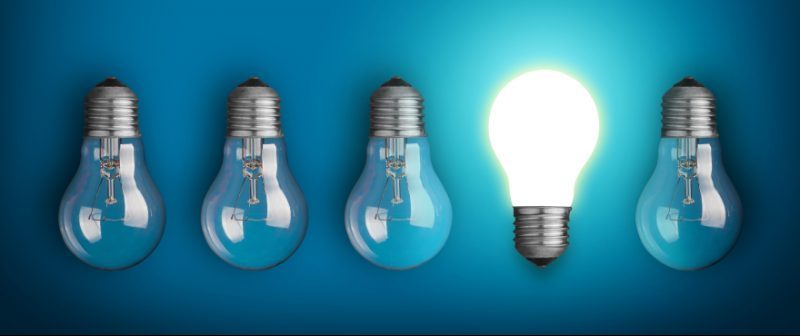There are several government initiatives that promote innovation, both within and across government agencies. Some are intended to eliminate waste by bringing in a “skunk works” style external group along the lines of Technology Fellows programs or the Food and Drug Administration’s Entrepreneurs-in-Residence. Other involve providing innovation funds within agencies to promote new ideas for fulfilling the organization’s mission and providing better services at a lower cost, such as the Department of Education’s Investing in Innovation (i3) fund.
To identify practices that may be relevant to a broader set of government innovation programs, we examined a subset of programs in the Federal government and the private sector in detail to see if lessons could be replicated in government organizations to help them better manage their innovation processes. In a report available here, we have identified practices that could serve as models for government agencies seeking to improve their innovative capacity by creating realistic visions, sourcing early stage ideas, implementing a phase-gate (or stage-gate) selection process, providing funding, and scaling-up the best ideas. The study was based on review of the literature, and interviews with leaders at government organizations like ARPA-E and DOE, private sector firms like Procter & Gamble, Apple, Boeing, Nokia, Nordstrom, and In-Q-Tel, among others, and lastly, business experts at IDEO, Lean Startup and universities.
We ofcourse recognize that the practices showcased are illustrative only; innovation is a broad and fluid concept, and not all practices can be transferred between the private and public sectors or between different agencies with different missions.
Defining the “Innovation Pipeline”
It is important to define the concept being examined, so we began with a definition of the term “innovation pipeline.” While it is by no means a linear process, innovation is typically visualized as a “pipeline,” which includes inputs, processes, and outputs. The term “innovation pipeline management” is an umbrella term used to describe the process used to analyze and manage early-stage concepts (O’Connor and Ayers 2005; Paulson, O’Connor, and Robeson 2007; Rosenø 2008).
These activities are generally described as an arrangement of phases that could be distilled down to five general categories: visioning and problem definition; idea generation; idea selection; developing, testing and prototyping; and implementation, scale-up and diffusion. Some experts characterize the pipeline as a “funnel” (as distinct from a straight-lined “tunnel”), with a high number of ideas in the early phases, combined with mechanisms to develop, evaluate and select the most valuable ideas (Hayes 1998, Jost, Lorenz, and Mischke 2005). The funnel highlights the boundary of the organization, and emphasizes the stage gate process of the innovation. In recent years, the process has been viewed as being “open” with ideas coming in and out of the system at all phases—see notional “holes” in the diagram below (Chesbrough 2004). Figure 1 presents these ideas in a notional diagram. Despite the linear look, the process is a continuous cycle with feedback loops between each stage, and where learning occurs through up- and downstream activities.
These phases are not always distinct or separate, but it is worth considering them separately, as such a conceptualization reinforces that the innovation process does have different stages, and that it is possible that different skills and methodologies will be needed at each stage. For example, idea generation is often about creativity, whereas idea selection needs to be informed by careful analysis, understanding of the problems at hand and the strategy and constraints facing the organization. Successfully scaling up, commercializing, or diffusing ideas depends on being able to distill the core attributes of the innovation, how and why it worked, and understanding what key aspects need to be replicated for it to succeed in different contexts.

Note: Feedback loops between stages are implied, not shown.
The latter stages of the pipeline tend to require greater focus on project management skills whereas earlier phases require greater focus on managing how new ideas are generated and converted into implementable plans. The actual implementation of these phases is highly dependent on the organizational goals and culture.
Summary of our Findings
With respect to defining the problem and creating a vision, organizations interested in effective visioning do not make the process unfettered. Their focus can be challenge-centric (as at DARPA or DOE’s Sunshot Initiative), user-centric (as at Boeing or Apple) or technology-centric (as at Sunshot). Gap identification is a critical part of visioning. As at Procter & Gamble and Boeing, insights are found in both adjacent spaces and with disruptive ideas.
For the ideation stage, innovative use of technology for idea generation (open platforms, prize administration) is useful, but only if incentives for participation are built into the platform architecture (as at HHSinnovates). To leverage their efforts, government agencies could take a page from Apple’s iphone app playbook, build a platform, and attract others to build alongside and on top of what they are doing.
Idea generation is enabled with a lower barrier to entry, as with Amazon.com, where suggestions can come from anywhere within and outside the organization. Innovative use of procurement instruments, as with VAi2’s use of BAAs, can lead to improvements in the quality and diversity of ideas.
In certain cases, the process of idea selection can be improved when decisions are made by limited-term staff that bring ideas from the outside, and are motivated to demonstrate value during their tenure, as with DARPA and ARPA-E. Given the uncertainty associated with innovation, final decision-making should be in the hands of a small number of in-house leaders with a strong incentive to see challenges addressed, as at P&G and the ARPA agencies. While fast and decisive decision-making is important, having transparency in the process is critical too, as at Department of Education’s i3 program.
For development, testing and prototyping, it may be useful to consider, as at Nordstrom and CMMI, the concept of making many small bets, and learning to fail fast and “pull the plug” if needed. This can be accomplished through hypothesis-driven experimentation with short cycles. At each of the stages, but especially toward the later ones, it also helps to set aggressive milestones, and de-fund projects that do not meet them, as is currently occurring at ARPA-E.
With respect to implementation, it is important to note that scale-up and deployment are as much a function of policy and economy as technology. So it is critical to build early linkages within the user-base and create “policy hooks” to integrate with broader/existing organization/system for quicker scale-up.
The Table below summarizes these practices. Please see full report Please see full report here.
| Innovation Pipeline Stage |
Practice |
| Problem Definition |
|
| Idea generation |
|
| Idea selection |
|
| Developing, Testing and Piloting |
|
| Implementation and Scale Up |
|
See full report here. Feel free to contact the authors if you have any questions.





Leave a Reply
You must be logged in to post a comment.